“The measure of intelligence is the ability to change.” — Albert Einstein
Erik ten Hag is widely regarded as an elite coach.
He is capable of deploying various tactics and using players in different ways to optimise his team’s performance by using his players’ strengths in innovative and unconventional ways.
Erik’s dynamism and automatism were evident in Ajax when he switched his positional approach from operating the midfield with Frenkie de Jong and Lasse Schone to Edson Álvarez and Ryan Gravenberch, using a different dynamic.
Yet, the team’s success remained largely unaffected.
Furthermore, his vision and ability to change the positions of some players and explore new capabilities to serve his systems, such as the conversion of Dušan Tadić into a false nine and Neres to a left winger, have enabled him to use players in various alternatives and variations to give the team greater flexibility to deal with any troubles in the different circumstances.
At Man United, after losing twice at the start of the season, the 53-year-old coach has demonstrated his pragmatism by making tactical adjustments which have turned United into a more flexible, competitive, winning team.
Man United currently don’t match what Ten Hag wants to implement, the team needs to squad modifications in the upcoming markets.
Prior to this, due to injuries, suspensions, and even the lack of quality in certain positions, especially in the midfield, Ten Hag sometimes needs to try new ideas.
This tactical analysis, in the form of a team scout report, illustrates how Erik Ten Hag has attempted to use Jadon Sancho in the midfield during Leicester, Barcelona and Southampton games with different tactics.
variant 1 vs Leicester
The game against Leicester like the Tottenham game, showed Ten Hag’s superb positional attack.
In the second half, Ten Hag pushed Sancho into the midfield to the right half-space.
Meanwhile, Bruno was playing as a right winger.
Putting Bruno and Sancho away from the congested central areas had impacted the dynamics as Bruno being out wide with an open body orientation meant more creativity and accurate crosses from the right, and a technical player like Sancho in half-space meant quick and precise combination plays.
The roamer in half-space or interior corridor can play 360° in a less crowded zone on the blindside of the central players, confusing the opposition’s centre-back and full-back about who is responsible to defend against them and has the chance to gain the numerical advantage by combining or gaining the dynamic superiority through runs in behind or to manipulate the fullback for the diagonal switch for the ball-far winger.
For Sancho’s goal against Leicester, after excellent proactivity from Lisandro Martínez and success to regain the ball from Daka in the centre, Rashford started the transition.
Here below, Once Wout Weghorst pulled Faes away, Sancho recognised the space and starts the vertical run on Soumaré’s blindside into the right channel to receive the pass, while Bruno holds the width.
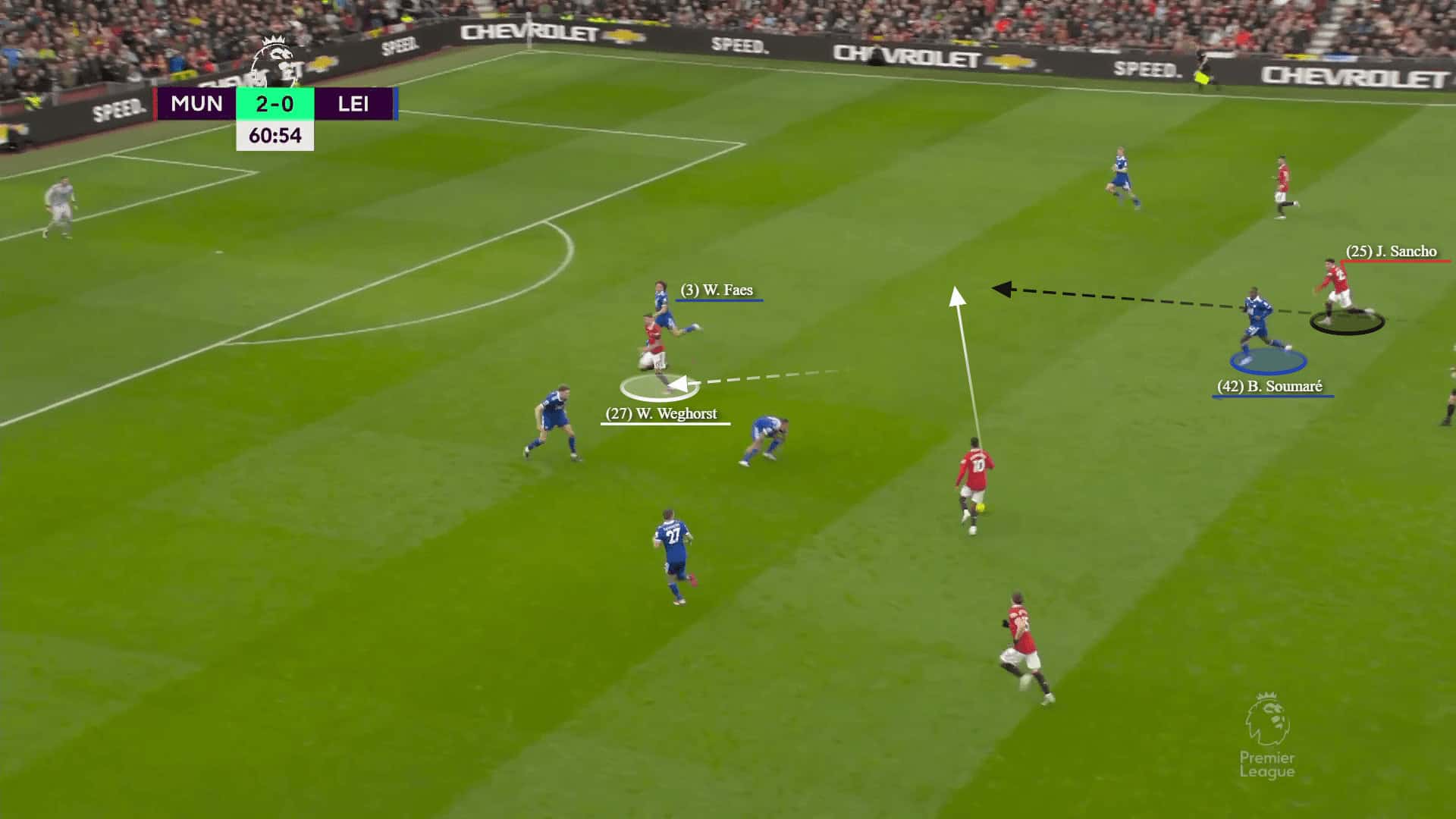
Both defenders had been provoked to press him, opening the space for the Portuguese playmaker and for Sancho to pass the ball to him.
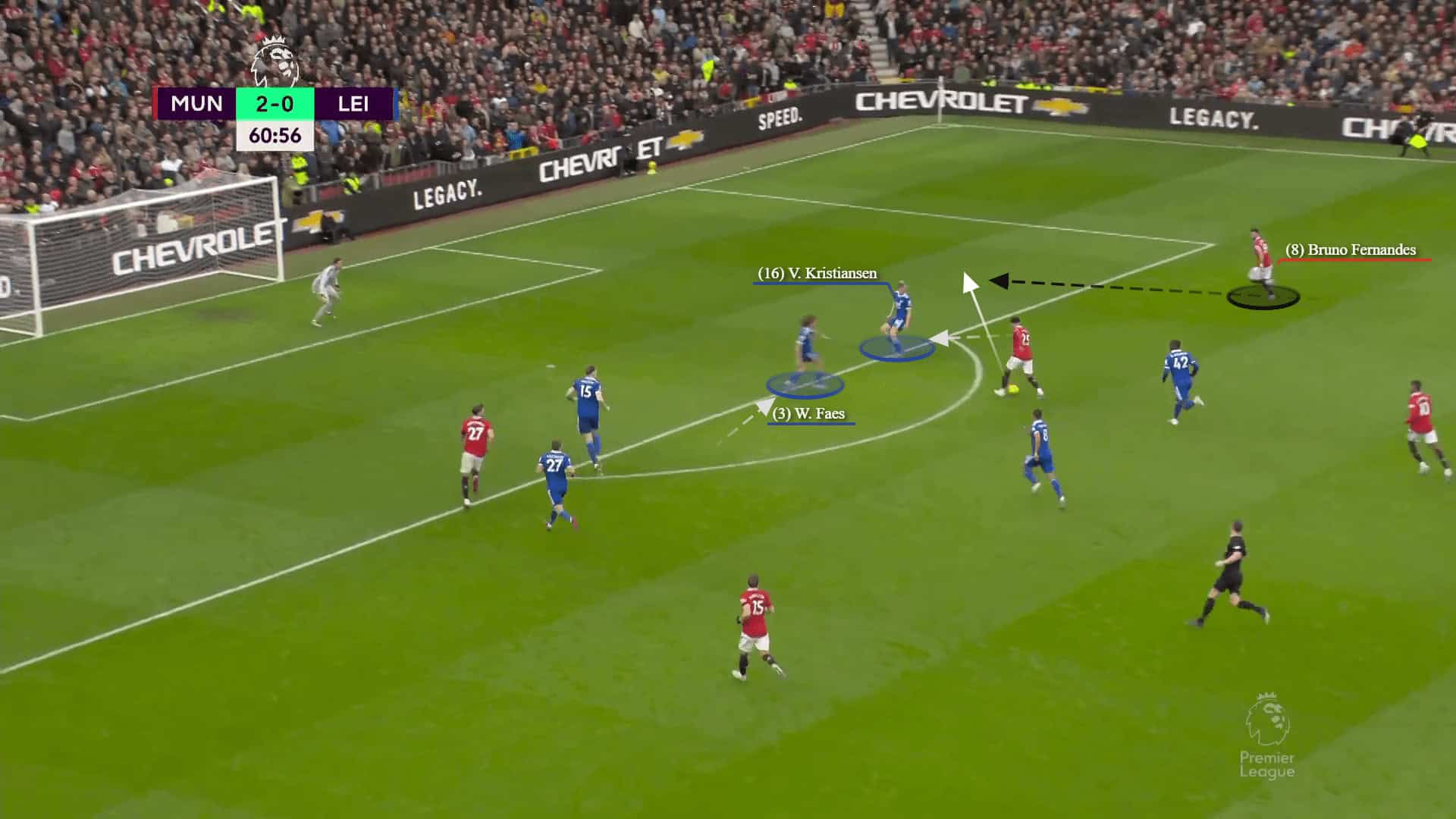
Cleverly, Jadon moves quickly to exploit the space to receive Bruno’s cutback then he taps it in to score.
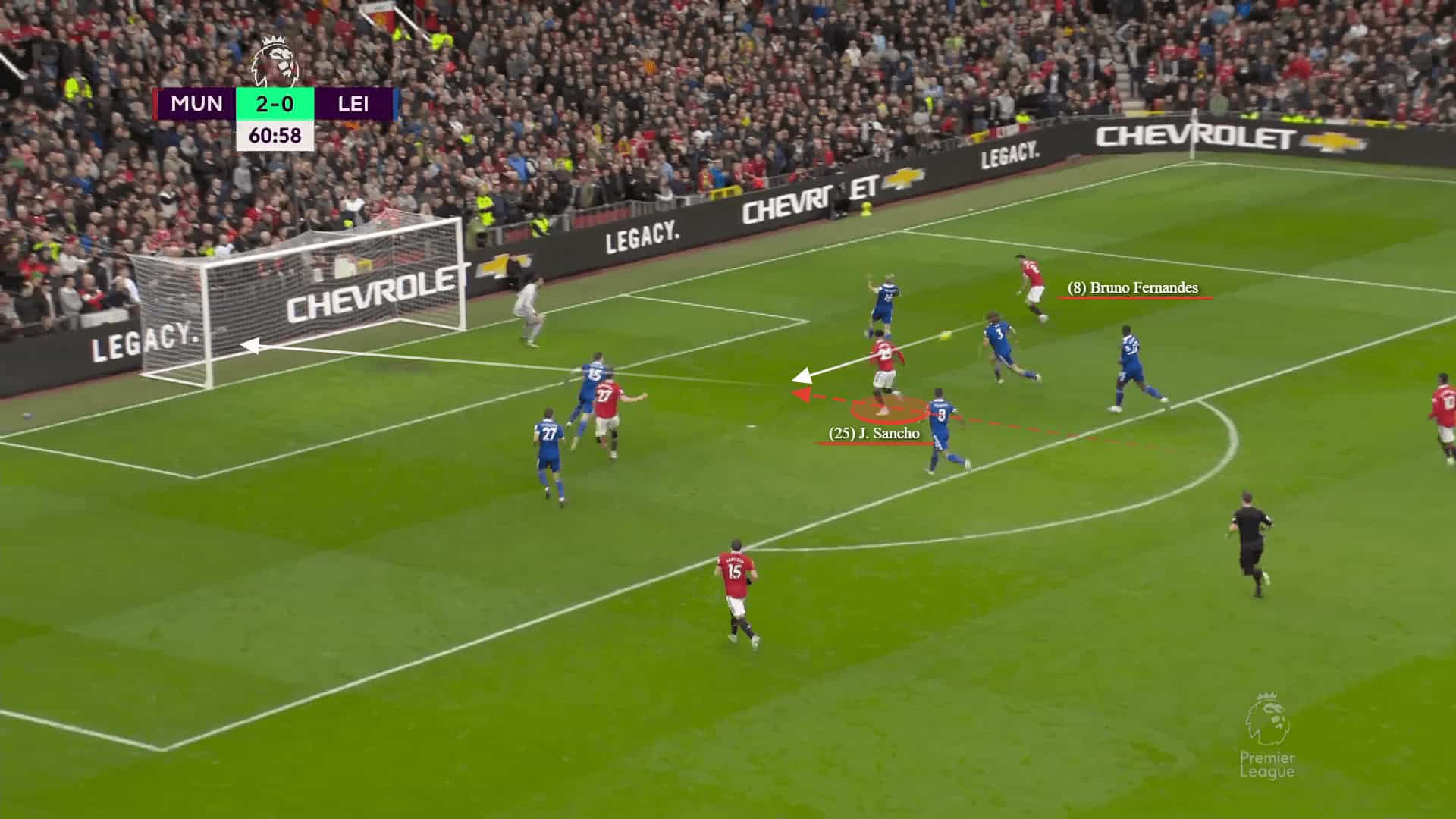
Furthermore, in the final third, the existence of Sancho and Bruno on the right flank makes Manchester United have varied styles on both sides, the right being more gravitational, involving in combinations.
In contrast, the left-hand side, where Rashford, Garnacho or even Elanga are more direct, can support the techniques of overloading to isolate or exploit the blindside for a cross.
The below scene is a perfect example of the right-side overloading.
After Dalot, Bruno and Sancho had been involved in a combination, dragging multiple defenders there while Shaw also inverted from the left back, Rashford was left isolated on the left flank.
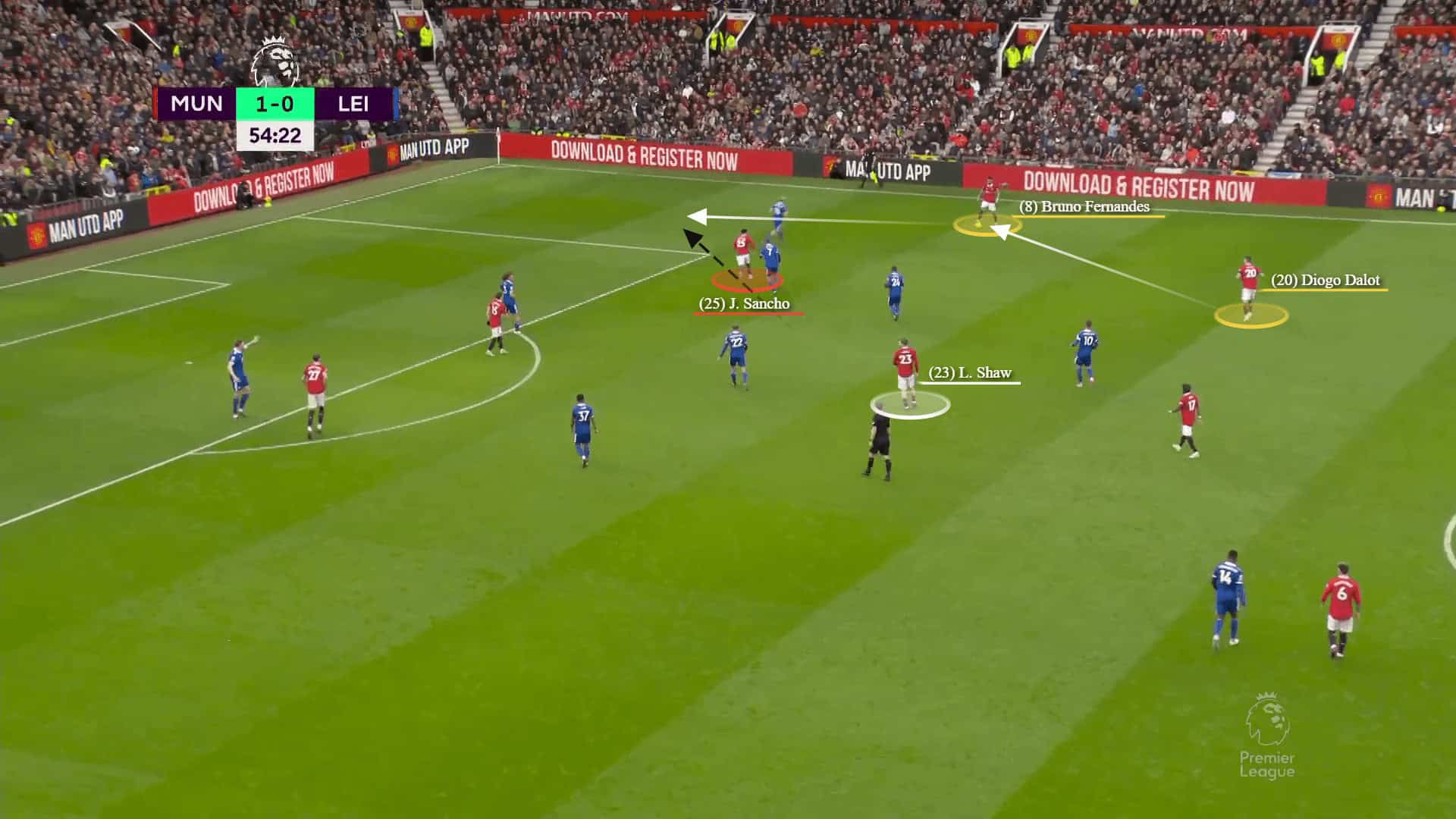
— and then Bruno cuts inside and targets Rashford who runs out-to-in, attacking Castagne’s blindside, gaining the dynamic advantage, yet the ball missed him.
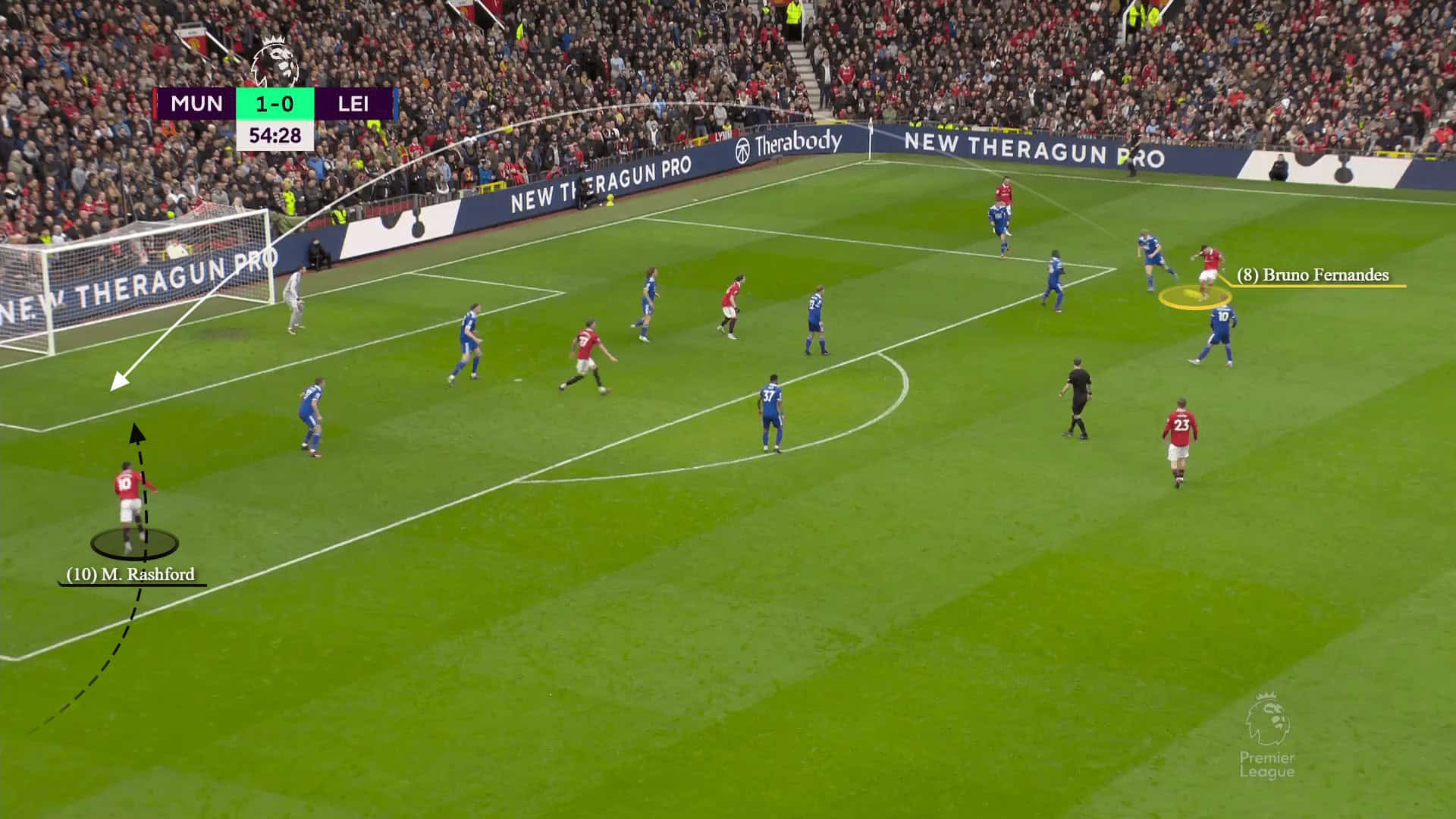
This was the same after Elanga and Wan-Bissaka came on.
Here, the right-hand side combinations and gravity have dragged five players out of position and left-back Dalot inverts which isolated the left-winger Elanga and gave Marcel Sabitzer room to attack the backline.

— and then Bruno switched the play to the weak side where Elanga was isolating with the fullback in a large space.
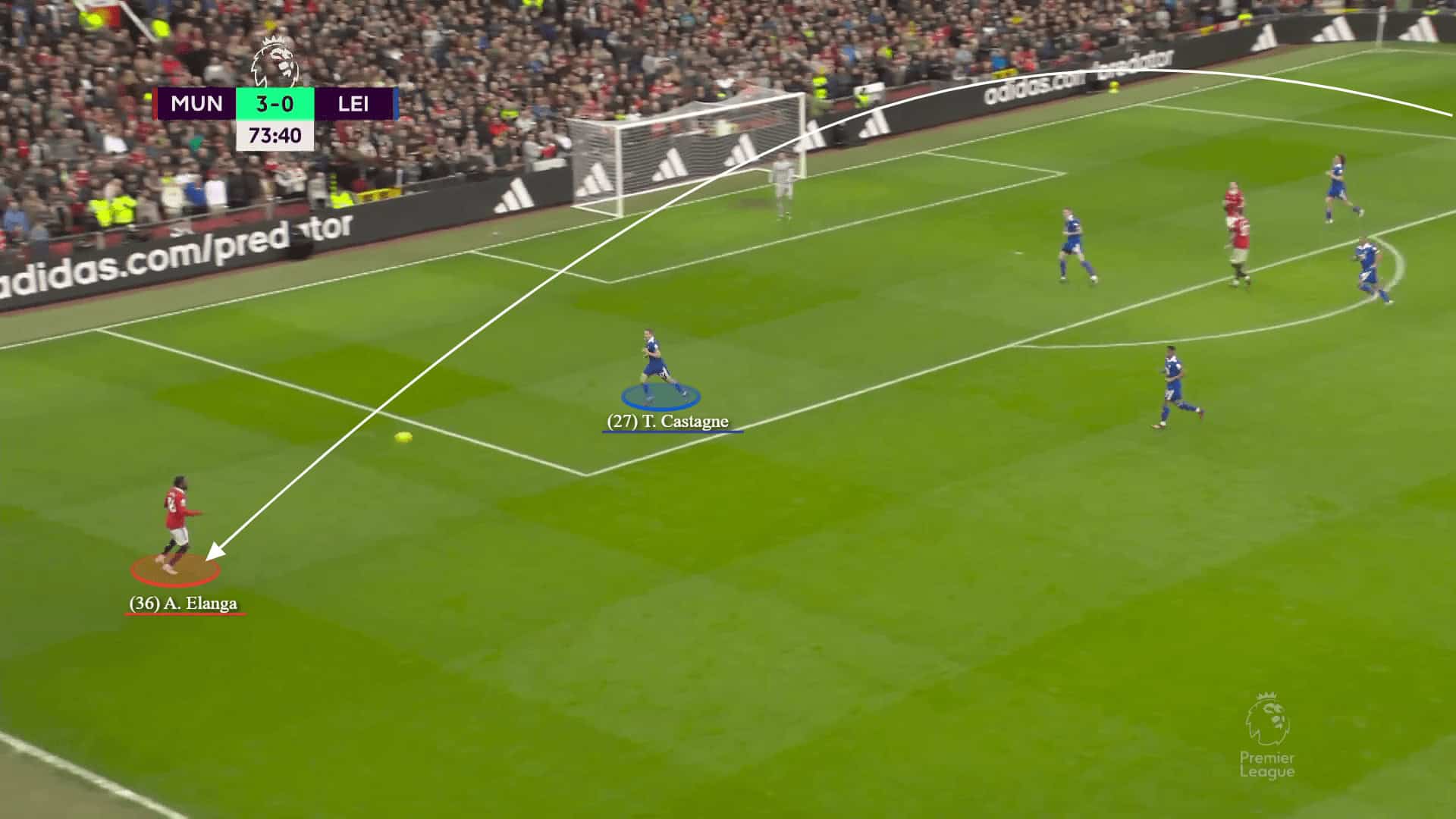
Commonly, in the final third, Jadon Sancho’s deep-lying runs can also be extremely effective like his goal.
He understands exactly when to attack the space and, most importantly, he is considered a gravity player, like Jack Grealish, who can attract the attention of many defenders.
Also, his excellent dribbling, passing ability and finishing are significant here in the box.
In the below scene, once Fred received in the centre, Jadon starts a sudden deep-lying vertical run in the half-space.
Unfortunately, Fred failed to reach him.
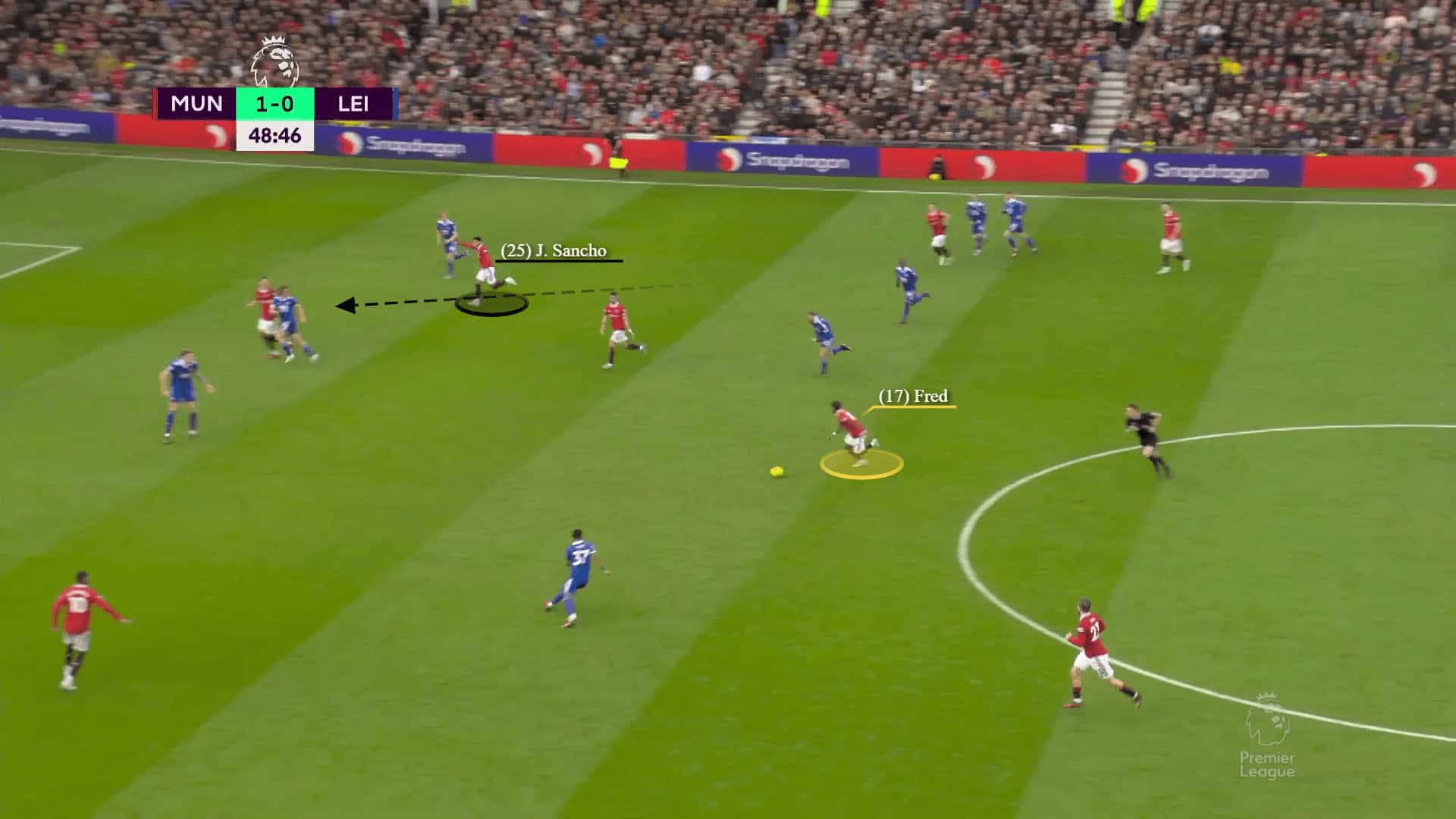
Also, in the below image, Sancho acted as the third man to attack the space to receive Weghorst’s pass in behind.
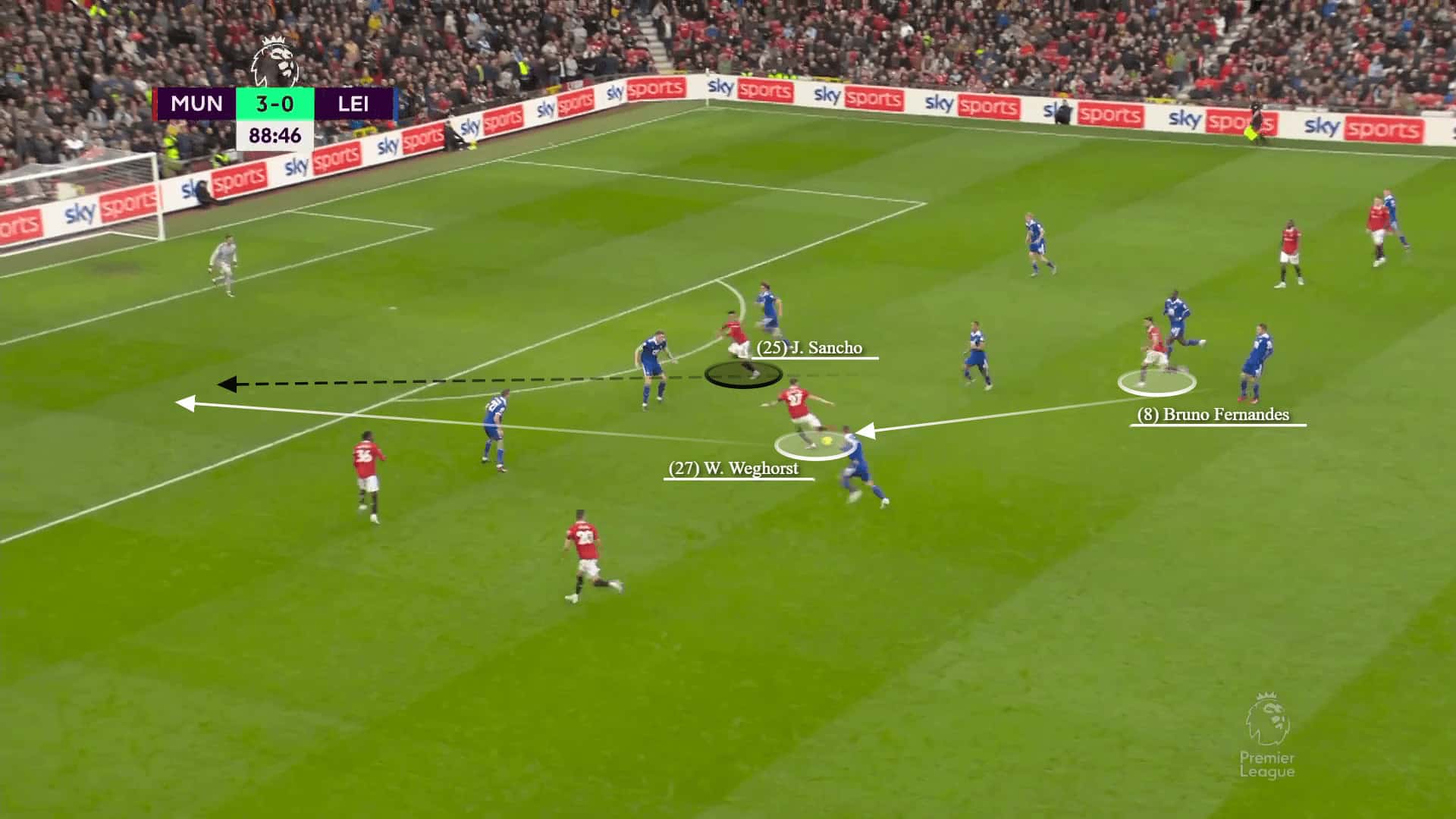
His technicality and functionality are efficient when spending the most time in the final third against low block teams.
After the Southampton game, Ten Hag said:
”I think he did quite well as a number 10.
Like he did against Barcelona and Leicester.
He was really decisive against Leicester and also today with some really good actions.”
But how did Sancho perform versus the Saints when playing alongside Antony while Fernandes was on the left?
Variant II vs Southampton
Ten Hag started against Southampton with a 4-3-3 formation, with Sancho as number ’10’ on the right corridor, Bruno the same but on the left, and Casemiro as number ‘6’.
Furthermore, Antony and Rashford were the wingers.
The game changed after Casemiro’s red card in the 34th minute, but before that, starting Bruno on the left increased the dynamism of the left side, overloading and creating a triangle with Shaw and Rashford.
Thus, with the repeated drops of Weghorst to combine, spaces and gaps were open for Sancho to exploit or engage in one-twos with Antony who was usually isolated in the right flank.
Here below, during the penetration, Weghorst dropped off to combine on the left side which dragged the opposition there and left Antony free on the right.
Meanwhile, the fullback was busy with Sancho.
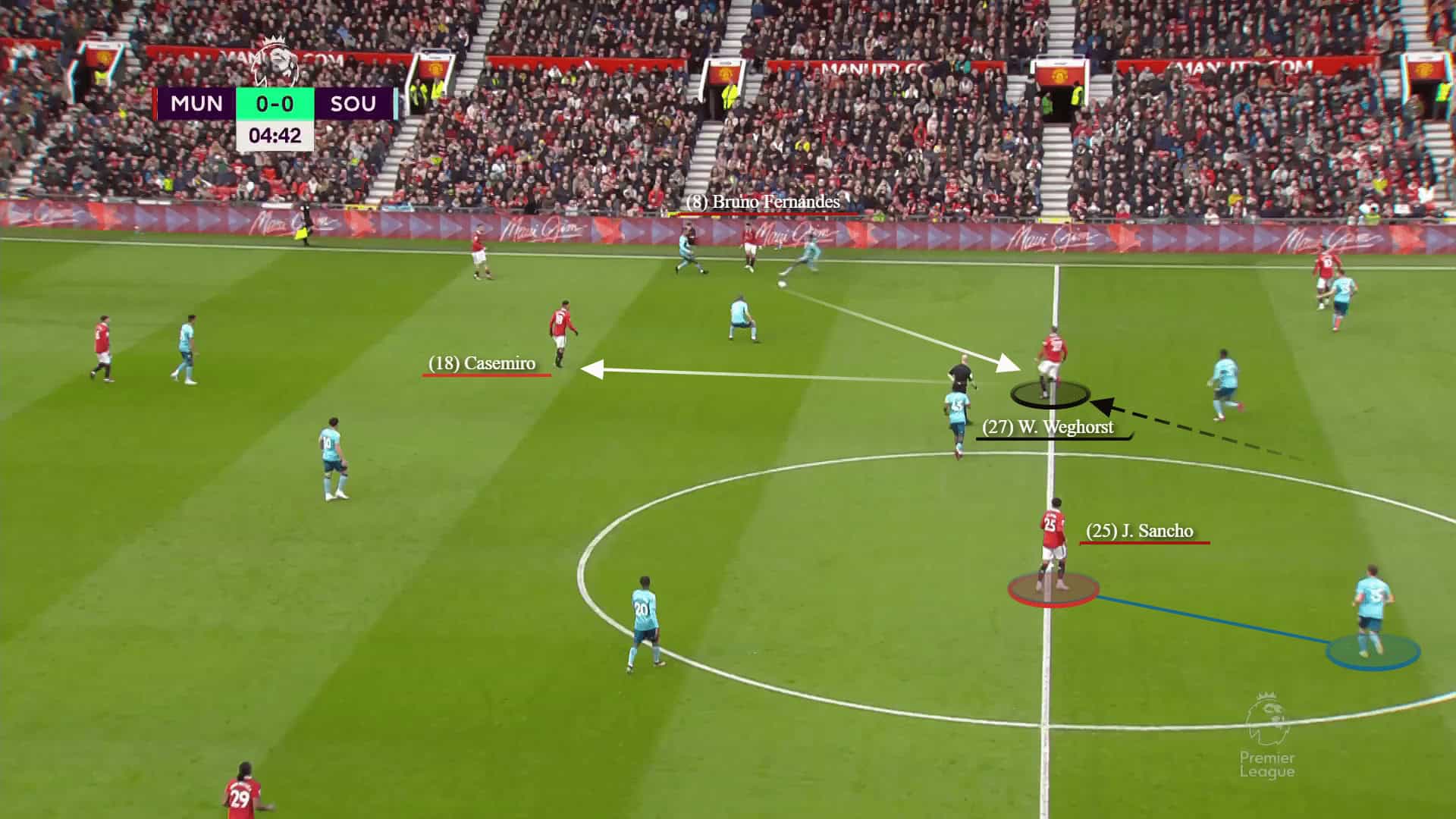
Once Casemiro received the wall pass, he switched the play to the weak side to Antony while Sancho and the rest were attacking the backline.
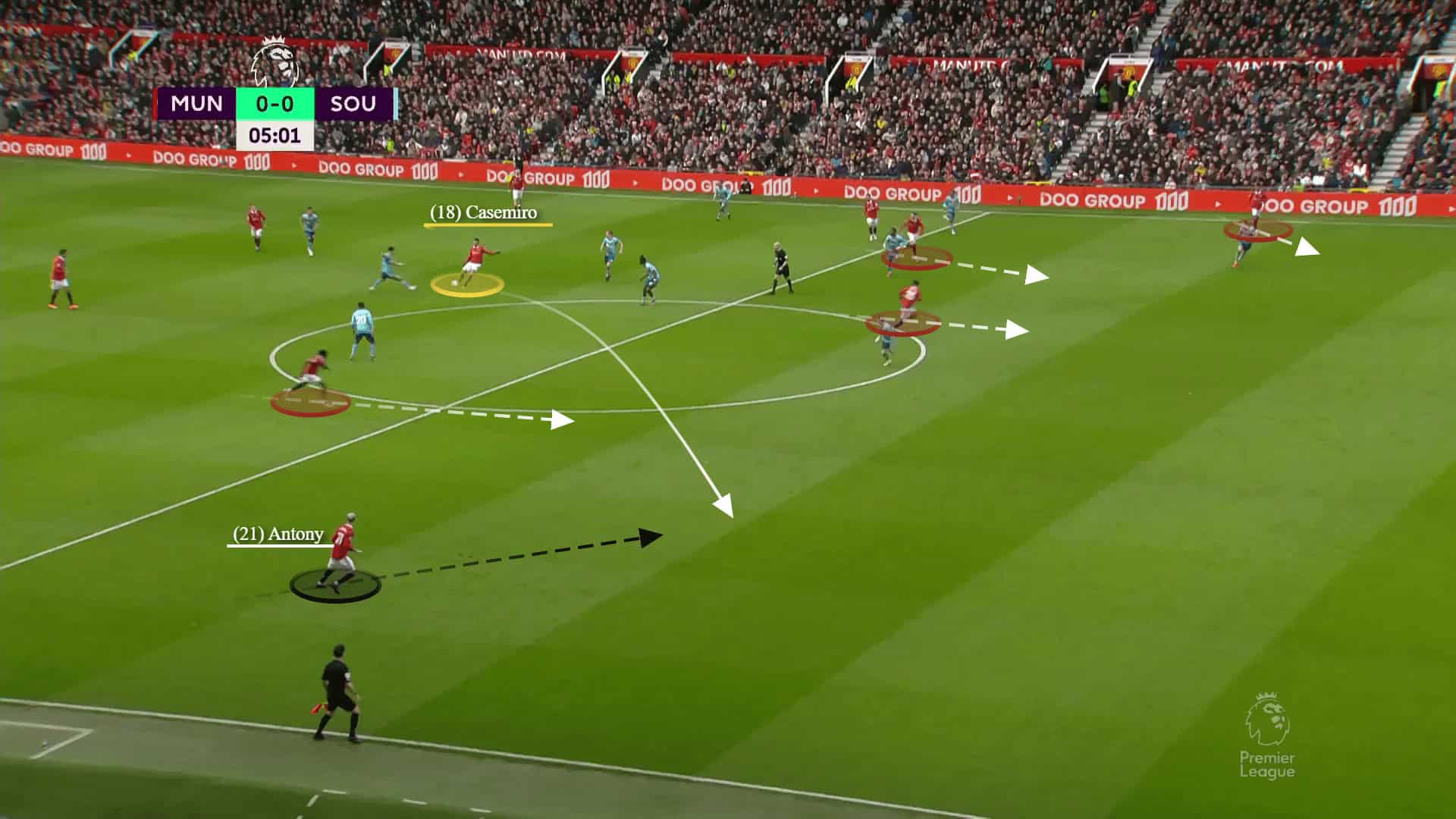
In contrast, defensively, Bruno and Sancho above Casemiro can have a significant defensive impact as it forces Casemiro to cover more ground and both centre-backs to be more proactive in confronting opponents coming into the half-spaces.
Therefore, the presence of Wan-Bissaka here is essential because of his defensive attributes and his being a part of the rest defence alongside Casemiro while in possession.
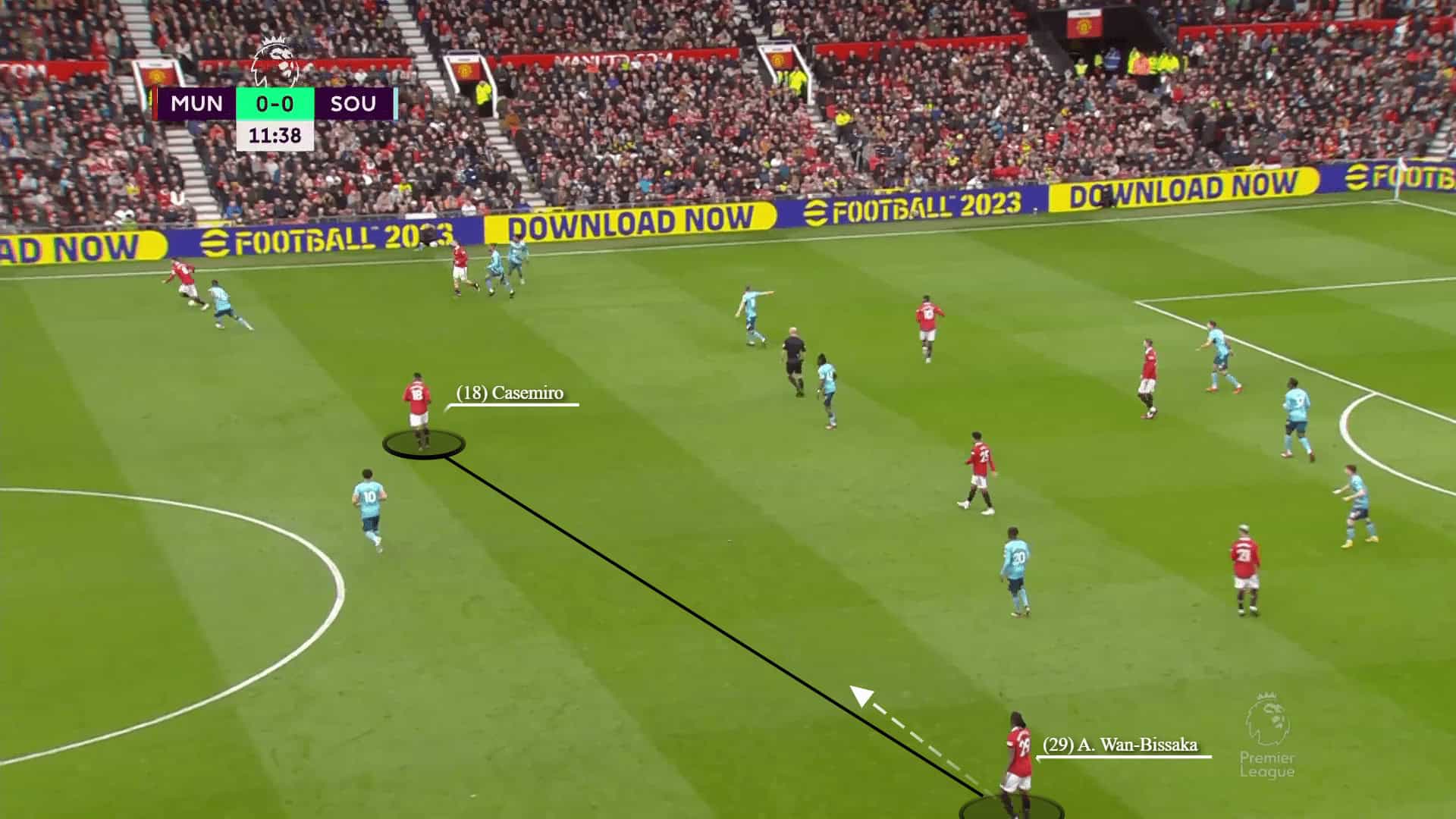
In the final third, having Bruno on the left means more vertical through passes to Rashford, while Sancho continues his deep-lying runs from the opposite half-space where the opposition has no time to react.
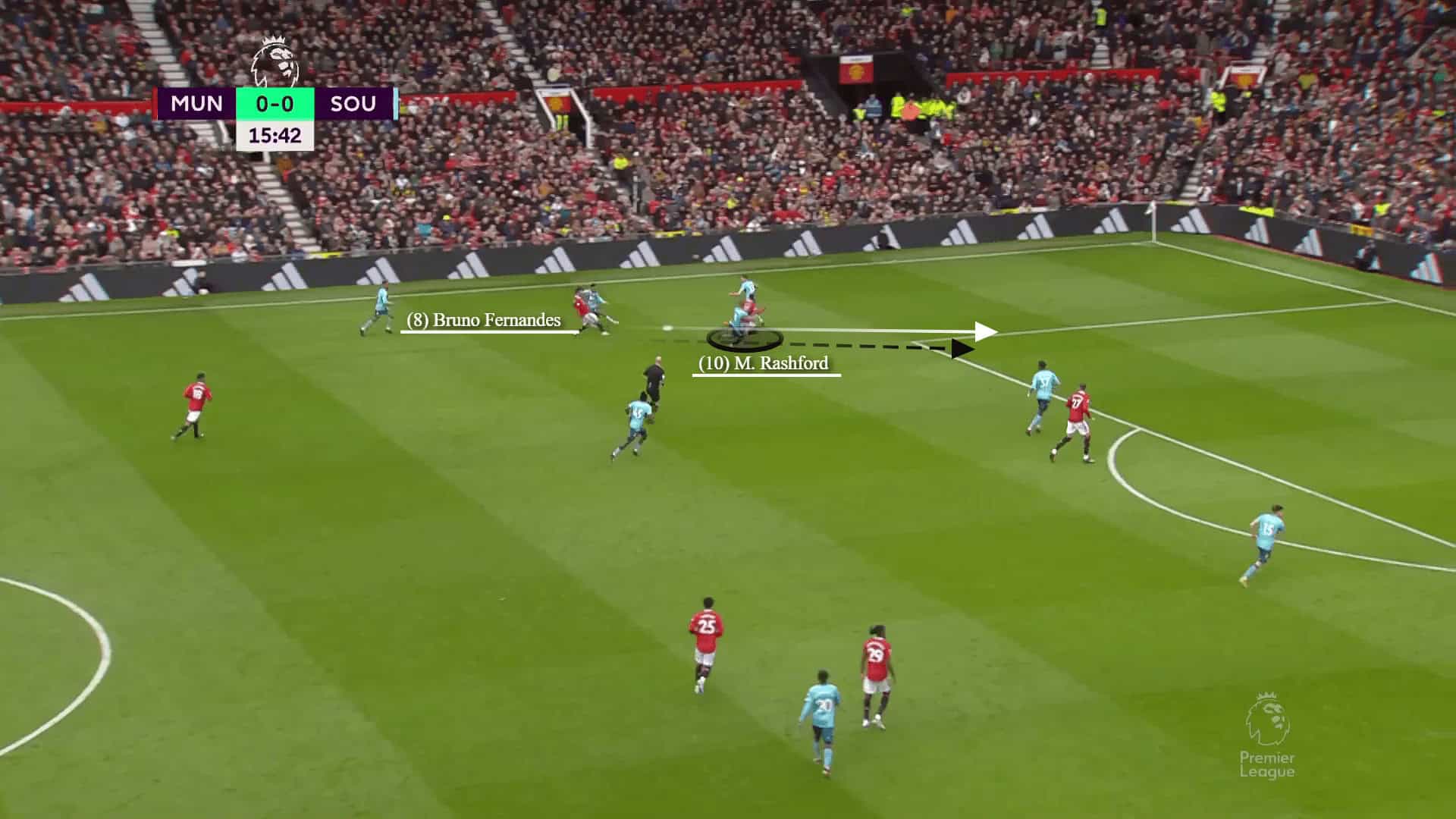
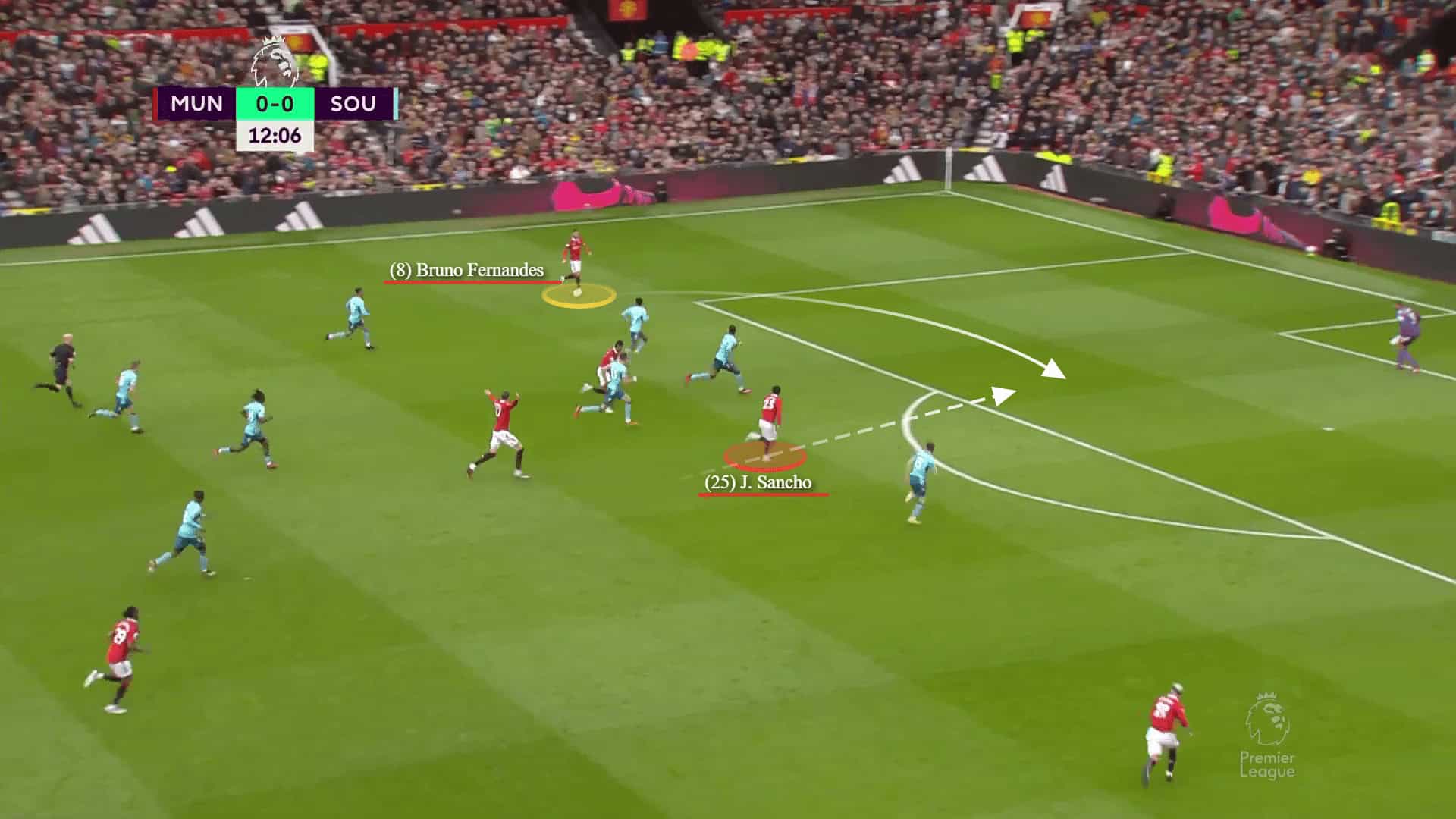
Variant III vs Barcelona
After only three days of the Leicester game, United faced Barcelona in the second leg of the playoff of the UEFA Europa League at Old Trafford.
Ten Hag decided to start Sancho as No 10 near the left half-space, opposite to the previous game, and Fred on the other one.
Bruno Fernandes began as the right winger.
Sancho’s positioning here is like Bruno’s in the Southampton game, involving more in left-sided combinations.
First and foremost, decisions in football are complicated because the game is interconnected and its phases are intertwined.
In both ping-pong games, both United and Barcelona failed to control the possession, except United in the physical aspects, but they both tried to counterattack as quickly as they can.
It was like turning the game into a physical, transitions game was Ten Hag’s idea to beat Barcelona in some aspects where the Premier League is sharper than La Liga.
The attempt to press and prevent Barcelona from possessing the ball had a defensive impact.
Accordingly, it was essential to press De Jong and Sergio Busquets carefully, thus Fred was on the right most of the time encountering and marking De Jong, and Sancho was there marking Busquets.
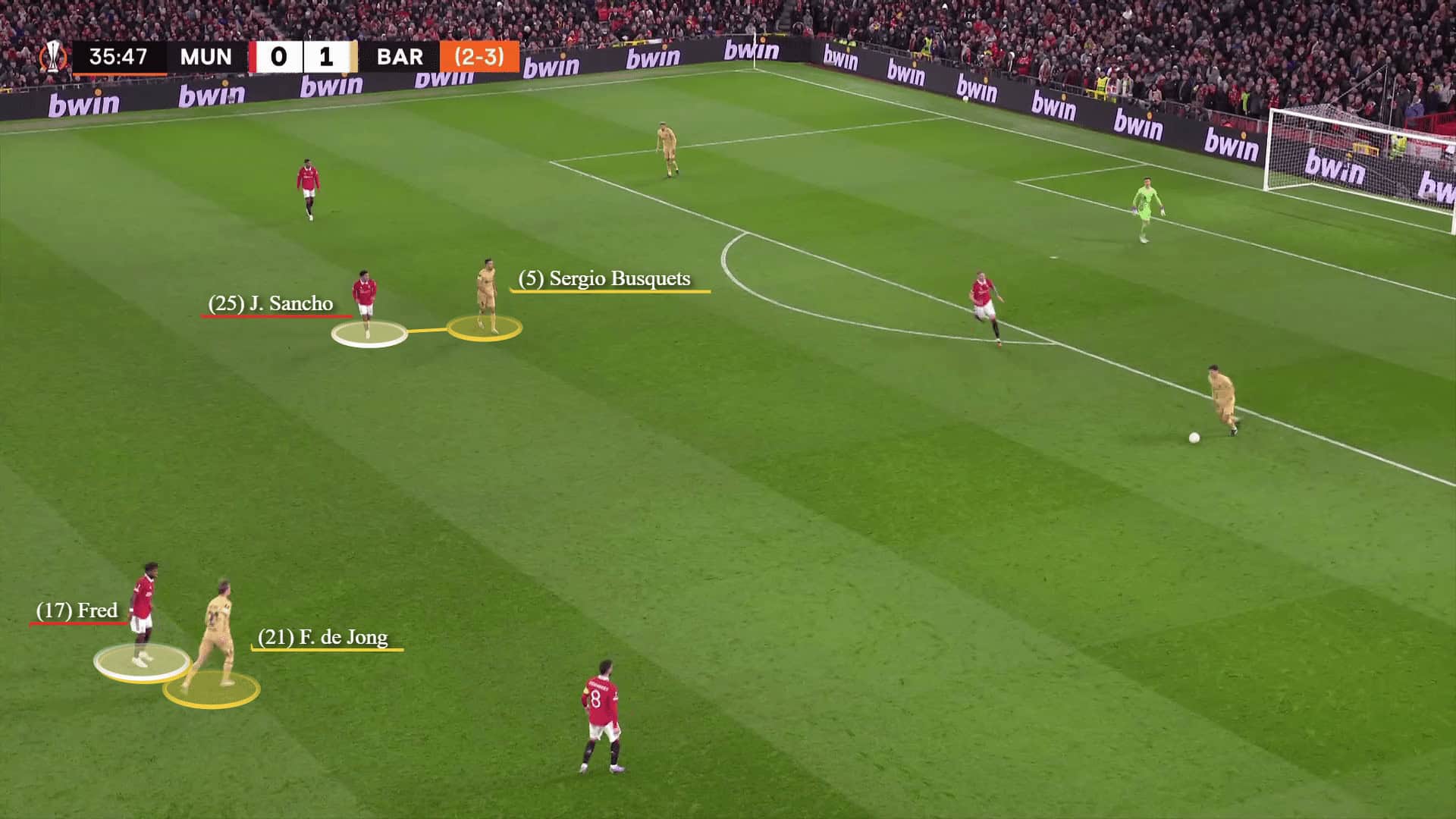
In contrast, Sancho was an excellent outlet to surpass Barca’s press while in possession.
He usually dropped off to create an extra option in the build-up, like in the image below.
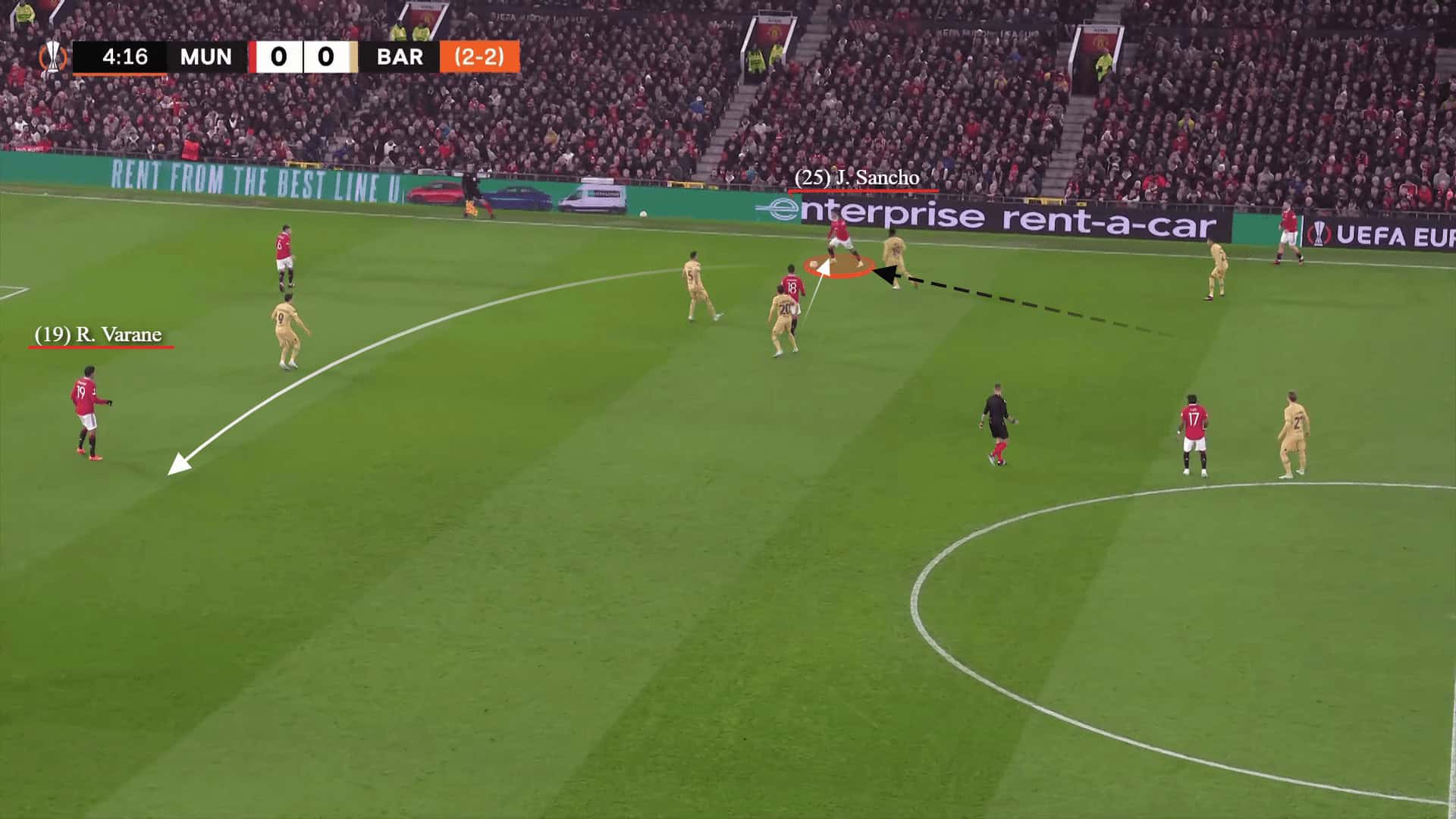
Sancho on the left rather than the right, even though he was a roamer, had an impact on Bruno’s performance in the first half, as the team’s playing density tended to lean towards the left.
The team missed Bruno in that area and did not benefit from him being isolated on the right.
However, Sancho maintained the same attitude to deep-lying runs but without making a significant impact.
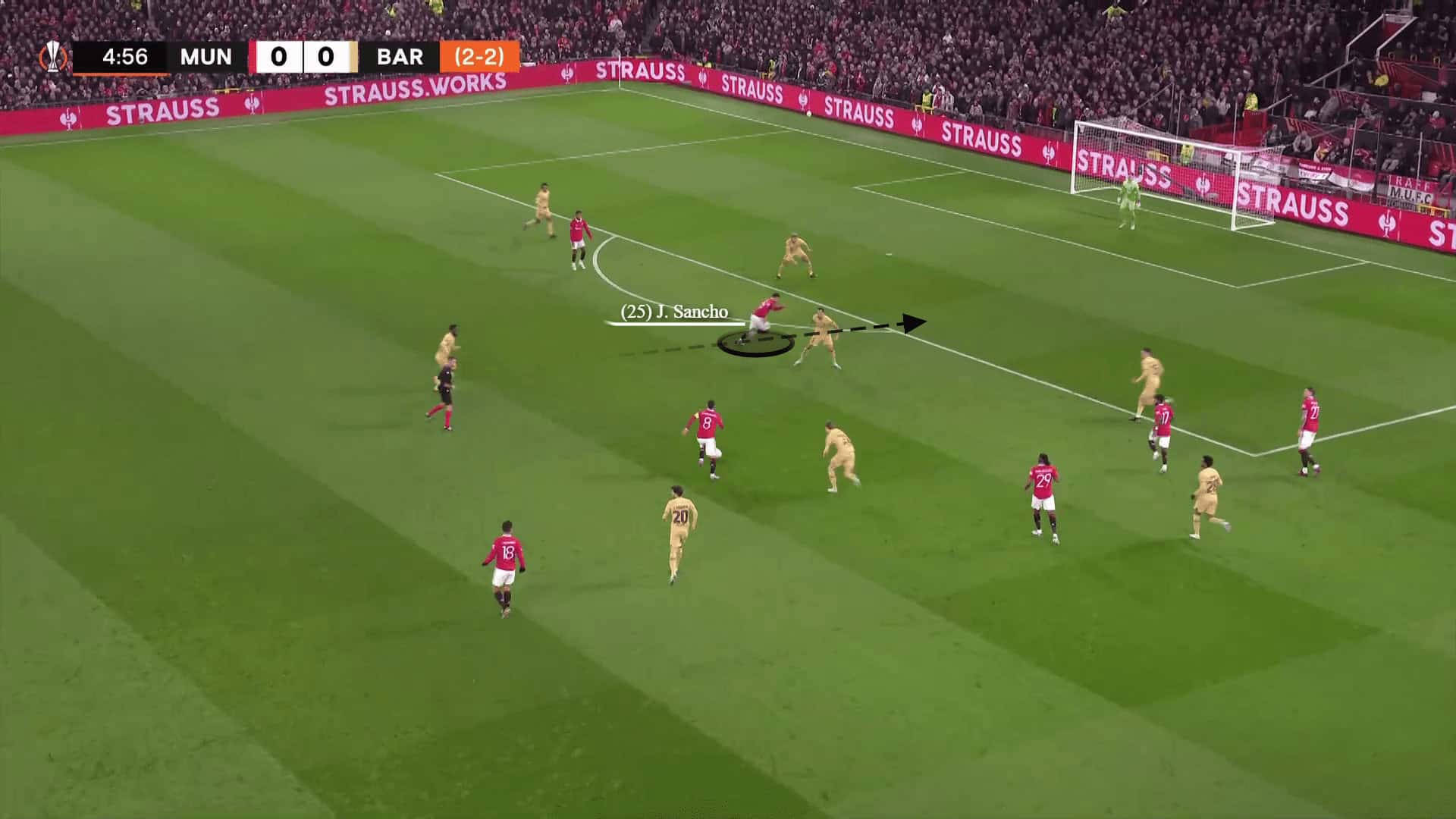
Conclusion
In conclusion, Erik ten Hag is a coach who is known for his dynamism and versatility in tactics.
His variety using Sancho away from the flanks may be a revival of his career with Manchester United.
It may also not be a primary plan but it is an effective variation in various situations.
This analysis has shown that Ten Hag is willing to experiment with players’ positions, such as with Jadon Sancho in the midfield, to find new ways to optimise the team’s potential.
Certainly, in the coming seasons, some players’ positions will change and the team will continue to develop more and more.





Comments